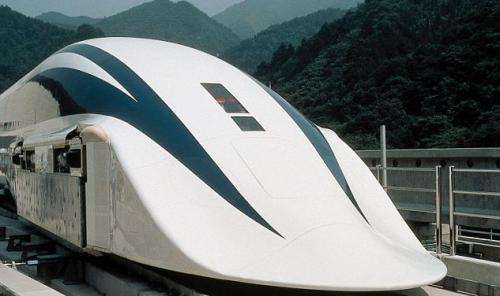November 28, 2012 report
Japan's newest floating train is one blistering maglev

(Phys.org)—Japan intends to outdo itself, rendering the sleek bullet train system that won it fame in the 1960s toward becoming so "yesterday." You can now look forward to the upcoming marvels of floating trains. The country known for its fast and efficient rail lines this month draws fresh attention after recently unveiling a magnetic levitation train that can travel at speeds over 310 mph. Japan is looking beyond its bullet train system as rail developers seek to excel globally once again, by offering a next-generation, no-wheels maglev (magnetic levitation) system. The maglev trains are frictionless, faster and are quieter than trains that use wheels.
According to the National High Magnetic Field Laboratory, maglev trains are propelled by varying shifts in horizontal magnetic fields that alternately attract and repel along the rails.
Central Japan Railway Co (JR Tokai) designed the maglev trains, which are scheduled for use in 2027. Earlier this month, JR Tokai unveiled its Series L0 prototype that utilizes maglev technology; the train can float above the track and travel with very high speed. The front car of the Series L0 maglev is about 92 feet long of which 49 feet forms an aerodynamic nose section. Asahi Shimbun said the streamlined nose is similar to those on its bullet train counterparts, which reduces wind drag. Asahi Shimbun also said there will be 14 carriages including the cab car. The carriages have four seats abreast; the end car can accommodate 24 passengers, while other cars will hold 68.
The new trains that are scheduled to go into use in 2027 are to link Shinagawa Station, in central Tokyo, with Nagoya and will travel at about 311 mph. It takes 90 minutes for a conventional, speedy bullet train to complete the journey between the two stations. The new train would complete the same trip in 40 minutes. "Through the test runs, we will make final checks to ensure that commercial services are comfortable,' said head developer, Yasukazu Endo. The extended plan is to have the new trains connect Tokyo to Osaka by 2045, Japan is also looking at its train technology's export potential. There is a commercial system operating in China; the maglev service is in place in Shanghai.
© 2012 Phys.org


















